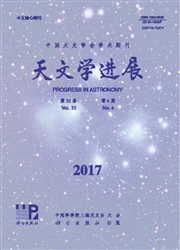

 中文摘要:
中文摘要:
简述了精确测定相对自行的方法,特别介绍了在用2—3个历元的底片和CCD观测结果推导恒星自行的过程中如何消除光学视场畸变、星等差和色差的具体办法;并介绍了用星系把相对自行推算绝对自行的方法。还介绍了用自行资料研究银河系结构和演化的一些前沿课题,其中包括星团研究、与银河系兼并的矮星系的发现、暗物质的检测、外星行星的探测和银河系中心黑洞的质量估算等。最后评价了自行在研究银河系中的重要性,论述了我国研制4m光学/近红外望远镜的重要意义。
 英文摘要:
英文摘要:
The methods of determinations of precise proper motions by using the observations with photographic plates and CCD at the 2-3 epochs are described. The detailed technique to eliminate Optical Field Angle Distortion (OFAD), magnitude equation, colour equation is given. In order to obtain the absolute proper motions referred to faint galaxies the procedure for determining the zero correction to relative proper motions is presented. For compiling a catalogue referred to the galaxies as the reference frame we should pay attention to the following 5 points:(1) The direct method will be adopted for determining the absolute proper motions referred to faint galaxies with observational data of POSS Ⅰ, POSS Ⅱ and new surveys. (2) The saturation always happens on photographic plates and the measuring error is relatively large for bright stars. It should be considered whether 2-3 order terms or high order terms in the plate model, corresponding to the reference stars down to 8.5 mat or all stars, are adopted. (3) The magnitude equations for stars and galaxies is different due to brightening of galaxies about -0.7 mag. The magnitude equation is not obtained for fainter stars if there is no reference stars. It should be derived by extrapolation or adding a term of magnitude equation in plate model. (4) The colour correction should be considered because QSO are blue celestial bodies and galaxies are red one. (5) The selection of galaxies is the first important work in constitution of extragalactic reference frame for determining the absolute proper motions. The systematic errors such as magnitude and colour equation etc. should be also considered and the moving average methods such as infinitely Overlapping circles or subplate will be adopted to eliminate accidental errors. There has been close relation between kinematics of the Galaxy and cosmology and the astro- metric parameters, specially, proper motions. The five front subjects in this field are described as follows: (1) Studying stel
 同期刊论文项目
同期刊论文项目
 同项目期刊论文
同项目期刊论文
 期刊信息
期刊信息
